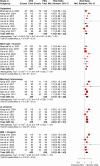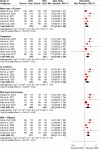Efficacy and safety of oral sulfate solution versus polyethylene glycol for colonoscopy: A systematic review and meta-analysis of randomized controlled trials
- PMID: 40248440
- PMCID: PMC12003215
- DOI: 10.1002/deo2.70113
Efficacy and safety of oral sulfate solution versus polyethylene glycol for colonoscopy: A systematic review and meta-analysis of randomized controlled trials
Abstract
Background: Colonoscopy is the gold standard for early detection and monitoring of colorectal cancer. Procedural effectiveness is dependent on optimal bowel preparation. Traditional polyethylene glycol (PEG) solutions are difficult to tolerate, whereas newer low-volume alternatives, including PEG with ascorbic acid and oral sulfate solutions (OSS), offer improved efficacy and tolerability. The meta-analysis was performed to evaluate the efficacy and safety of OSS compared to PEG for bowel preparation in colonoscopy.
Methods: Studies were identified by searching PubMed, Embase, Cochrane CENTRAL, and clinicaltrials.gov from inception until June 2024. Only randomized controlled trials comparing OSS with PEG were included. Data was analyzed using R version 4.4.0 using a random effects model to calculate risk ratios (RRs) and mean differences (MDs) with 95% confidence intervals (CIs).
Results: Twenty-one studies with 6346 participants met the inclusion criteria. OSS significantly improved adenoma detection (RR, 1.13; 95% CI, 1.04-1.22; p-value <0.01; I2 = 0%) and polyp detection rates (RR, 1.16; 95% CI, 1.06-1.26; p-value <0.01; I2 = 0%), and had a higher Boston Bowel Preparation Scale (BBPS) score (MD, 0.31; 95% CI, 0.13-0.50; p-value <0.01; I2 = 81%). PEG was associated with more sleep disturbances (RR, 0.45; 95% CI, 0.25-0.82; p-value = 0.03; I2 = 0%). However, other adverse effects were similar between both solutions.
Conclusion: OSS demonstrated superior adenoma and polyp detection rates. When compared to PEG, patients utilizing OSS achieved higher BBPS scores. Data gleaned support enhanced cleansing efficacy and safety of OSS as a bowel preparation regimen.
Keywords: adenoma; colonoscopy; colorectal neoplasms; meta‐analysis; polyethylene glycols.
© 2025 The Author(s). DEN Open published by John Wiley & Sons Australia, Ltd on behalf of Japan Gastroenterological Endoscopy Society.
Conflict of interest statement
None.
Figures







References
-
- Morgan E, Arnold M, Gini A et al. Global burden of colorectal cancer in 2020 and 2040: Incidence and mortality estimates from GLOBOCAN. Gut 2023; 72: 338–44. - PubMed
-
- Siegel RL, Wagle NS, Cercek A, Smith RA, Jemal A. Colorectal cancer statistics, 2023. CA Cancer J Clin 2023; 73: 233–54. - PubMed
-
- Lin JS, Piper MA, Perdue LA et al. Screening for colorectal cancer: Updated evidence report and systematic review for the US preventive services task force. JAMA ‐ Journal of the American Medical Association 2016; 315: 2576–94. - PubMed
-
- Faivre J, Dancourt V, Lejeune C et al. Reduction in colorectal cancer mortality by fecal occult blood screening in a French controlled study. Gastroenterology 2004; 126: 1674–80. - PubMed
Publication types
LinkOut - more resources
Full Text Sources
Research Materials
Miscellaneous
